When it comes to premium cuts of beef, bone in ribeye steak is in a league of its own. This king of steaks delivers incredible marbling, bold flavor, and unmatched tenderness. Whether you’re grilling for a summer cookout or searing a perfect crust indoors, knowing how to cook a bone in ribeye steak is essential for meat lovers who crave steakhouse-level results at home.
In this guide, we’ll cover everything you need to master the art of the bone in ribeye steak from selecting the right cut and seasoning it correctly to avoiding common cooking mistakes and serving it with flavorful sides. You’ll also learn how to repurpose leftovers into amazing new meals.
Don’t miss our Almond Chicken for another protein-rich favorite, and discover creamy comfort with this Low-Carb Chicken Alfredo Bake. Both are perfect complements to your meat-loving menu.
Table of Contents
Bone-In Ribeye Steak
What Is a Bone-In Ribeye Steak?
A bone in ribeye steak is cut from the rib section of the cow and includes the rib bone, which enhances flavor during the cooking process. It’s packed with marbling those thin streaks of intramuscular fat that melt during cooking to create a buttery, juicy bite.
Unlike boneless cuts, the bone in ribeye steak benefits from added insulation during cooking. The bone slows down the heat, keeping the steak juicier and helping it cook more evenly. This is also why many chefs and pitmasters prefer it when grilling or reverse-searing.
Some popular versions of this steak include the cowboy ribeye and the tomahawk steak, which is known for its long, dramatic bone. Both are showstoppers for any occasion.
Why It’s Known as the King of Steaks
The bone in ribeye steak has rightfully earned its reputation as the king of steaks. It’s incredibly flavorful, thanks to high marbling and the bone’s influence during cooking. The result? A crusty exterior and tender interior that’s bursting with deep beefy taste.
It’s also one of the most forgiving steaks you can cook. The fat renders beautifully and helps protect the meat from overcooking, making it ideal even for less experienced cooks.
Pairing it with complementary sides and drinks only enhances its power. This hearty steak can hold its own with a bold red wine, peppercorn sauce, or garlic herb butter.
Looking for inspiration? Try this savory Hot Honey Beef Bowl or serve your steak with pillowy Cottage Cheese Bread that sops up every last bite.
Choosing the Right Cut of Bone-In Ribeye
How to Select the Perfect Bone-In Ribeye Steak
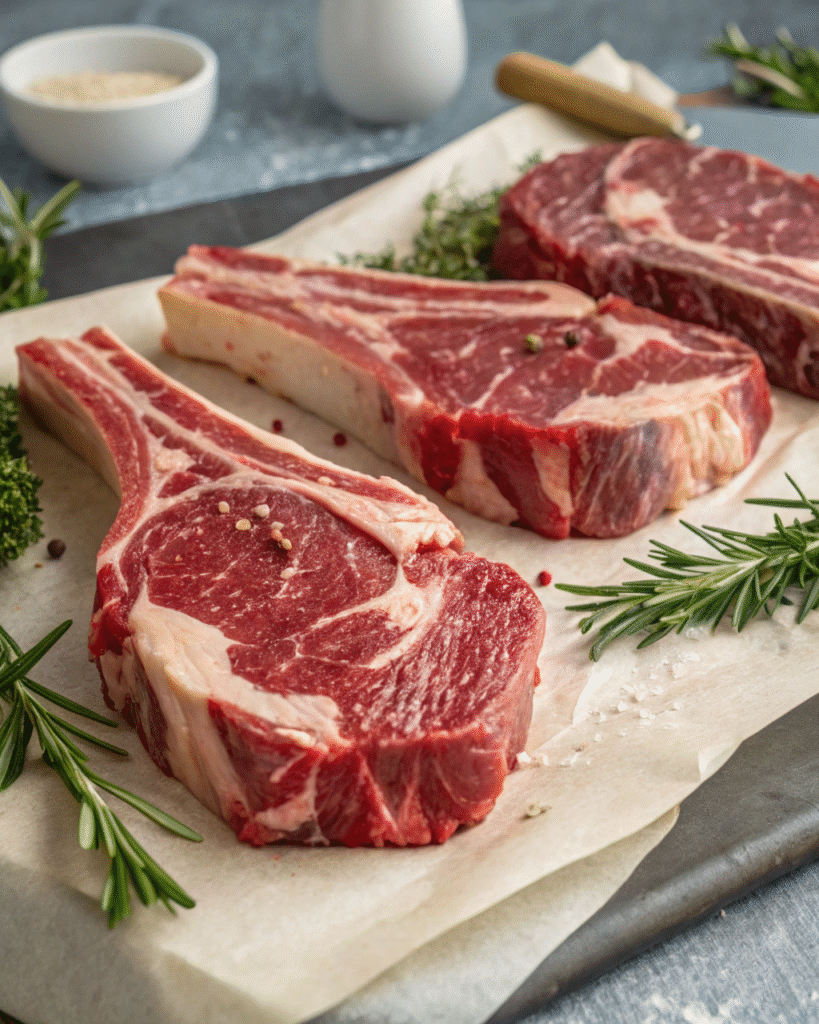
Choosing the best bone in ribeye steak starts at the butcher counter. Not all steaks are created equal, and paying attention to key details will ensure your ribeye delivers on tenderness, flavor, and texture.
First, look for visible marbling those creamy white streaks of fat running through the meat. The more marbling, the more flavorful and juicier the steak will be. A high-quality bone in ribeye steak will have a thick eye of meat surrounded by fat cap and spinalis (the prized ribeye cap), which adds buttery richness.
Second, thickness matters. Aim for a cut that’s at least 1.25 to 2 inches thick. Thicker steaks are ideal for grilling or reverse searing since they can build a perfect crust without overcooking the inside.
Lastly, check the bone. A short bone is often found on cowboy ribeye cuts, while tomahawk steaks come with an extended bone for dramatic presentation. The bone adds insulation during cooking and enhances depth of flavor.
Discover great ideas like this Grinder Sandwich for using leftover steak or pair your ribeye with this rustic Pappardelle Pasta for a hearty side.
USDA Grades: Prime vs Choice vs Select
Understanding USDA grading helps you choose a ribeye that matches your flavor expectations and budget. These grades are based on marbling and age of the animal, and they directly affect tenderness and juiciness.
- Prime Ribeye: This is the highest grade, packed with intense marbling and unbeatable flavor. Found in steakhouses and specialty butcher shops, a bone in ribeye steak labeled USDA Prime is worth every cent for special occasions.
- Choice Ribeye: Slightly less marbled than Prime, but still tender and flavorful. This is the most common grade found in grocery stores and a great pick for home cooking.
- Select Ribeye: Leaner and less tender. This option works better for recipes where the steak is marinated or slow-cooked, but it lacks the luxurious texture that makes a ribeye shine.
Pro Tip: Always choose Prime or upper-level Choice for grilling. These grades bring out the best in a bone in ribeye steak, especially when seared hot and finished slow.
Don’t miss our Carrot Ribbon Salad as a vibrant side to contrast the richness of the steak, or add freshness with this Mediterranean Cucumber Salad. Both pair perfectly with beef.
Preparation Before Cooking
Best Practices for Seasoning Bone-In Ribeye Steak
Before you ever fire up the grill or heat your cast iron, proper seasoning is what brings out the depth of flavor in your bone in ribeye steak. Unlike lean cuts, ribeye thrives on simplicity let the meat shine.
Start with a generous sprinkle of kosher salt. It penetrates the meat better than table salt and helps draw out moisture that creates that signature crust. Follow with freshly cracked black pepper. Optionally, you can add garlic powder, smoked paprika, or even a light rub of rosemary for added aroma.
Dry seasoning should be applied at least 40 minutes before cooking, or even the night before for a dry-brined effect. This gives the salt time to dissolve and reabsorb, leading to juicier bites.
Want to enhance the crust? Pat the steak dry with paper towels before it hits the heat. Moisture is the enemy of a good sear.
Looking for more cooking hacks? Check out this Banana Recipe to Lose Weight for quick morning fuel or get creative with Cucumber Lemon Water for a steak-night refreshment option.
Room Temperature, Dry-Age & Marinade Tips
Let your bone in ribeye steak rest at room temperature for 30 to 45 minutes before cooking. Cold meat won’t cook evenly, and you’ll lose that perfect edge-to-edge doneness.
If you’re lucky enough to score a dry-aged bone in ribeye steak, treat it with care. Dry-aged beef has concentrated flavor due to the evaporation of moisture and enzymatic breakdown. These cuts are more expensive, but they offer unmatched umami taste and tenderness.
Not all ribeyes need a marinade, but if you’re using USDA Select grade, a simple blend of olive oil, garlic, balsamic vinegar, and rosemary can help tenderize and add moisture.
Avoid acidic marinades for more than 2 hours they can break down the muscle too much and create a mushy texture.
For a nostalgic comfort pairing, explore our Pink Salt Recipe to Lose Weight which offers a bold, mineral-rich flavor or go full savory with the unique Cheddar Corn Pie for a Southern-style finish.
Cooking Methods for Bone-In Ribeye Steak
Pan-Searing, Grilling, Broiling, and Sous Vide
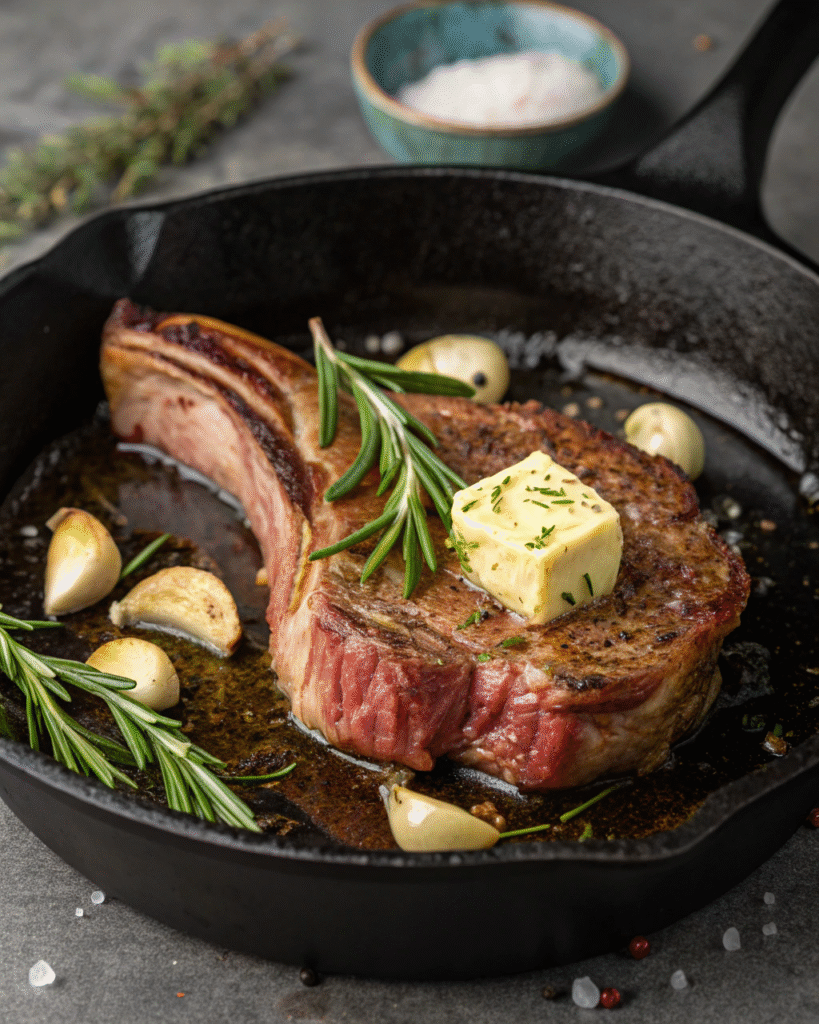
Cooking a bone in ribeye steak is more than following a recipe it’s about technique. Whether you’re aiming for a sizzling crust or a buttery pink center, the method you choose makes all the difference.
Pan-searing in cast iron is a go-to for steak lovers. Heat your pan until smoking hot, then sear each side of your bone in ribeye steak for 3–4 minutes. Baste it with butter, garlic, and herbs for added richness. Don’t forget to sear the fat cap and edges by holding the steak upright with tongs.
Grilling gives that signature char and smoky flavor. Preheat your grill to high. Place the bone in ribeye steak over direct heat for a quick crust, then move it to indirect heat to finish cooking to your preferred doneness.
Broiling mimics steakhouse ovens. Place your steak on a rack under a broiler and flip halfway through. Keep a close eye to prevent overcooking.
Sous vide offers precision. Set your water bath to your target doneness (see chart below), seal your steak in a vacuum bag, and cook for 1–2 hours. Finish with a high-heat sear in a cast iron skillet.
Looking for big flavor in small bites? Try our Rock Bottom Pie as a rich, post-steak dessert or sip on a detox-friendly Saunf Tea to refresh your palate post-meal.
Bone-In Ribeye Internal Temperature & Doneness Chart
Getting the temperature right is crucial. Use a meat thermometer for accuracy and let your bone in ribeye steak rest 5–10 minutes after cooking to retain its juices.
| Doneness | Internal Temp (°F) | Appearance |
|---|---|---|
| Rare | 120–125°F | Cool red center |
| Medium Rare | 130–135°F | Warm red center |
| Medium | 140–145°F | Pink and firm |
| Medium Well | 150–155°F | Slightly pink center |
| Well Done | 160°F+ | Little to no pink |
For most flavor and texture, medium-rare is the gold standard for a bone in ribeye steak. It’s juicy, tender, and lets the fat fully render without drying the meat.
Want to elevate the experience? Reverse searing slowly cooking your bone in ribeye steak in the oven or sous vide, then finishing it in a blazing hot skillet creates a deep crust without overcooking the center.
Check out our Banana Bread Latte for a cozy after-steak beverage or whip up a light Dandelion Tea Recipe to help aid digestion.
Bone-In vs Boneless Ribeye Which Is Better?
Flavor Differences Between Bone-In and Boneless Ribeye
One of the biggest arguments for choosing a bone in ribeye steak over a boneless cut is the flavor. Many chefs and home cooks believe the bone acts as a natural insulator, slowing the cooking process and keeping juices locked inside. This results in a tender steak with intensified beefy notes.
While boneless ribeye still offers great marbling and tenderness, bone in ribeye steak has the edge when it comes to complexity of flavor and presentation. The bone itself may not add flavor to the meat, but the way it affects heat distribution absolutely does.
Plus, cooking a steak with the bone still attached allows the surrounding fat and connective tissues to baste the meat from within. The result? A richer, more luxurious bite especially when seared properly.
Looking to pair flavors creatively? Don’t miss our Cottage Cheese Ranch Dip for a creamy, protein-packed side or try our fresh, light Dense Bean Salad as a fiber-rich partner to your ribeye.
Cooking Performance and Tenderness Comparison
From a technical standpoint, bone in ribeye steak takes longer to cook due to the bone’s density, which slows down heat penetration. But that’s actually a benefit it allows for even cooking and better control over doneness.
In contrast, boneless ribeye cooks faster but can be more prone to overcooking if you’re not paying close attention. It’s more convenient for slicing and fits better in pans, making it slightly more practical in small kitchens.
When it comes to texture, bone-in wins again. The connective tissues around the bone break down during cooking, adding to the overall tenderness and giving the steak a slightly buttery mouthfeel.
Presentation-wise, a bone in ribeye steak looks more impressive on the plate. Whether it’s a tomahawk cut or a thick cowboy ribeye, the bone adds visual drama and elegance that’s hard to beat.
Discover bold ideas like our Dubai Chocolate Strawberries for a luxurious dessert finish or bring balance with Lactose-Free Cottage Cheese as a creamy, gut-friendly side.
Serving & Pairing Your Bone-In Ribeye
Perfect Side Dishes for Ribeye Steak
A bone in ribeye steak is bold, rich, and decadent and the sides you serve can either enhance or overwhelm its flavor. The goal is to create balance on the plate without stealing the spotlight.
Start with something starchy and grounding, like roasted garlic mashed potatoes or a baked sweet potato. If you prefer a low-carb route, creamy cauliflower mash works wonders.
Vegetable sides like roasted Brussels sprouts, garlic green beans, or grilled asparagus complement the steak’s savory richness without overpowering it. For something bright and crunchy, a shaved fennel salad or pickled onions help cut through the fat.
Looking for a creative twist? Pair your steak with our Vegan Banana Pudding as a dairy-free dessert option or start your meal with a spoonful of this zesty Detox Island Green Smoothie. They bring contrast, freshness, and color to the table.
Wine and Sauce Pairings That Elevate the Meal
When it comes to drinks, few things match the luxurious bite of a bone in ribeye steak like a deep, tannic red wine. Look for wines that have body and structure, such as:
- Cabernet Sauvignon: Full-bodied with rich blackberry and cedar notes
- Malbec: Bold, juicy, and slightly spicy
- Zinfandel: Slightly sweeter and fruit-forward for grilled versions
Not a wine fan? A cold, dry stout or rich porter complements the char on a grilled bone in ribeye steak beautifully. Sparkling water with citrus is another good choice to cleanse the palate between bites.
As for sauces, you can’t go wrong with classic compound butter, béarnaise, or a homemade chimichurri. These additions enhance without masking the steak’s natural flavor.
Need more ideas? Try our Protein Baked Oats as a post-steak breakfast option or refresh your evening with an indulgent Nightingale Ice Cream Sandwiches Banana Pudding. They’re the perfect way to end a satisfying steak night.
Common Mistakes to Avoid When Cooking Ribeye
Overcooking and Underseasoning Mistakes
Cooking a bone in ribeye steak seems simple until it isn’t. One of the most frequent mistakes is overcooking, especially with thick cuts. Because ribeye has rich marbling and a built-in bone, it retains heat longer. That means it can keep cooking even after you remove it from the heat.
Use a meat thermometer and pull your steak off the heat about 5°F before it reaches your target doneness. Resting the steak for at least 10 minutes lets juices redistribute and finish the cooking process naturally.
Another common misstep is not seasoning enough. A bone in ribeye steak has deep beefy flavor, but it still needs help from kosher salt and fresh black pepper. Too little seasoning leads to bland results, especially on the crust. For the perfect sear, dry your steak thoroughly and salt it well ahead of time.
Don’t miss our Cottage Cheese Bagels for a protein-rich breakfast after steak night or enjoy the richness of this silky Dubai Chocolate Bar to follow a perfectly cooked meal.
Not Letting It Rest: Why Timing Matters
You’ve cooked the perfect bone in ribeye steak now don’t ruin it by cutting too soon. Slicing immediately causes all those flavorful juices to run out onto the cutting board instead of staying in your steak.
Let it rest, loosely tented with foil, for 5 to 10 minutes before slicing. This helps retain moisture and tenderness, especially in thick steaks like a tomahawk or cowboy cut.
Another mistake? Cutting with the grain. Always slice against the grain to shorten muscle fibers and make the steak more tender in every bite.
Skipping preheat on your grill or pan is another rookie error. If your skillet isn’t ripping hot, your bone in ribeye steak won’t form a crust and crust equals flavor.
Looking for bold flavor variety? Try our Pink Salt Trick for Weight Loss in your next rub, or explore the savory layers in our Cottage Cheese Bread as a complementary side.
Nutrition & Health Benefits of Bone-In Ribeye
Nutritional Breakdown (Include Table)
While often labeled as indulgent, the bone in ribeye steak is also packed with essential nutrients that support a strong and active lifestyle. Its combination of protein, healthy fats, iron, and vitamins makes it more than just a comfort food it’s a power-packed source of nourishment when consumed in moderation.
Here’s a nutritional snapshot of a typical 12-ounce bone in ribeye steak, cooked to medium-rare with minimal oil:
| Nutrient | Amount |
|---|---|
| Calories | ~950 kcal |
| Protein | 68g |
| Total Fat | 75g |
| Saturated Fat | 30g |
| Iron | 3.5 mg |
| Zinc | 9 mg |
| Vitamin B12 | 2.5 mcg |
| Omega-3 Fats | 140 mg |
The high fat content especially from marbling contributes to the bone in ribeye steak’s tenderness and flavor. However, it also provides essential fatty acids and fat-soluble vitamins that support hormone health, brain function, and energy regulation.
Looking for high-protein breakfast options after steak night? Check out our Air Fryer Date Smores for a naturally sweet recovery snack or enjoy our fluffy Cottage Cheese Pancakes as a balanced post-meal brunch.
Is Bone-In Ribeye Good for Keto, Paleo, and High-Protein Diets?
Absolutely. The bone in ribeye steak is an excellent fit for popular low-carb, high-fat diets like Keto and Paleo. It provides the kind of fat that fuels ketosis and offers a high protein-to-carb ratio, with virtually zero carbohydrates per serving.
For Paleo followers, this steak is a clean, whole-food protein source that aligns with ancestral eating principles. Skip the processed marinades and go with a dry rub of herbs, garlic, and salt to stay true to the diet.
On high-protein diets, the steak delivers long-lasting satiety, supports muscle repair, and helps regulate blood sugar when paired with low-glycemic sides.
If you’re managing weight, just be mindful of portion size and choose grass-fed beef when possible for higher omega-3s and fewer inflammatory compounds.
Don’t miss our Brazilian Mounjaro Recipe – 3 Ingredients for a simple, low-carb fat-burner idea or refresh your plate with a vibrant Strawberry Banana Pudding that balances richness with fruit-based lightness.
Creative Recipes Using Leftover Bone-In Ribeye
Ribeye Steak Sandwiches and Tacos
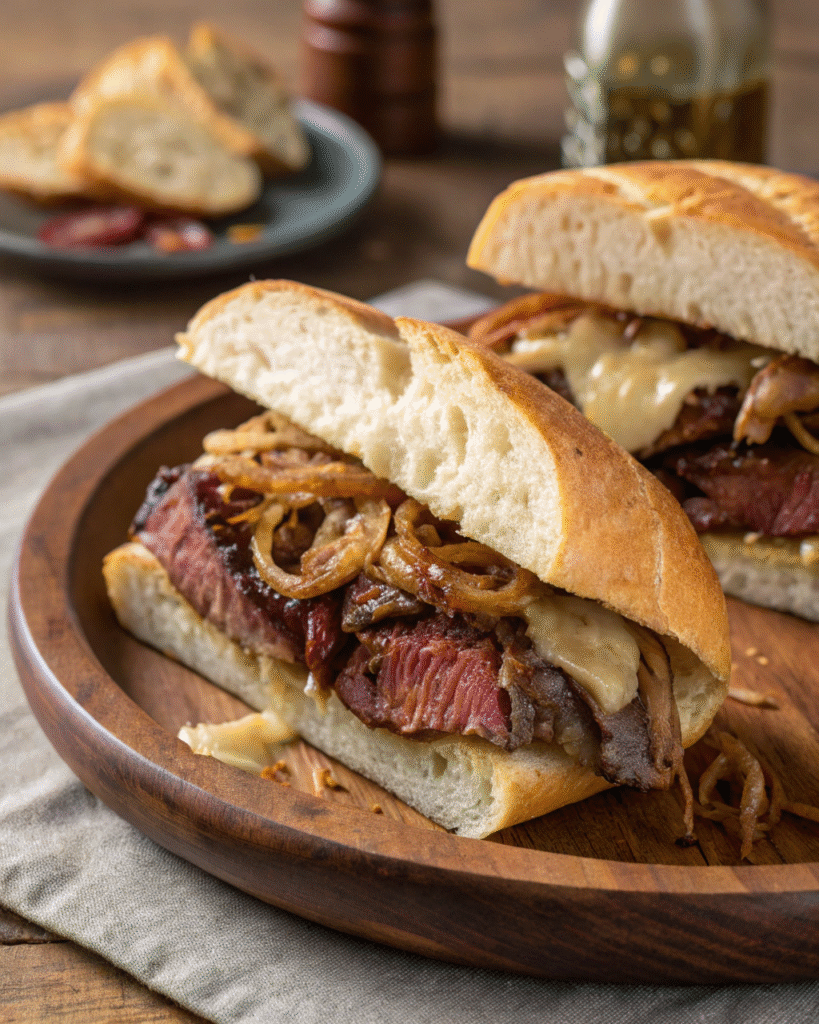
Leftover bone in ribeye steak shouldn’t go to waste. In fact, it might be even more flavorful the next day. With a little creativity, you can turn those leftovers into delicious new meals that taste just as satisfying as the original steak dinner.
One easy and crowd-pleasing idea is a ribeye sandwich. Thinly slice the leftover steak against the grain and layer it on a toasted ciabatta roll with caramelized onions, sharp cheddar, and a smear of horseradish mayo. For a twist, add arugula and roasted red peppers for extra depth.
Prefer something handheld and bold? Try steak tacos. Warm corn tortillas, pile on the chopped bone in ribeye steak, and top with avocado, pickled onions, and a squeeze of lime. It’s a fast and flavorful way to transform dinner into a fun next-day meal.
Looking for flavor-packed inspiration? Discover our Grinder Sandwich for another meaty masterpiece or try the hearty Dense Bean Salad as a high-protein taco side.
Bone Broth or Beef Stew from Ribeye Bones
Don’t toss that ribeye bone. It’s packed with collagen, marrow, and savory flavor that’s ideal for soups and stews.
To make homemade bone broth, simmer your ribeye bone in water with aromatics like onions, garlic, celery, bay leaf, and peppercorns for 8–12 hours. This rich broth can be sipped on its own or used as a base for hearty soups, sauces, or risottos.
Want something even cozier? Turn your leftovers into a slow-cooked beef stew. Chop the steak into chunks, simmer it with your ribeye bone, potatoes, carrots, and herbs for a soul-warming one-pot dinner. The depth of flavor from the ribeye bone makes a major difference.
For creative and comforting alternatives, explore our Mango Propitious Ice Cream for dessert, or finish strong with the creamy delight of our Fumang Propitious Mango Ice Cream. They’re the perfect sweet contrast to a savory stew.
Frequently Asked Questions About Bone In Ribeye Steak
What is the best way to cook a ribeye bone-in?
The best way to cook a u003cstrongu003ebone in ribeye steaku003c/strongu003e is a combination of reverse searing and high-heat finishing. Start by slowly roasting the steak in the oven at 250°F until it reaches an internal temperature of about 120°F for medium-rare. Then, sear it in a hot cast iron skillet with butter, garlic, and herbs until a deep crust forms. This method gives you edge-to-edge doneness with a restaurant-quality sear.
Is ribeye steak better with bone-in?
Many chefs agree that u003cstrongu003ebone in ribeye steaku003c/strongu003e offers a richer, more complex flavor compared to boneless cuts. The bone acts as insulation during cooking, helping the steak retain moisture and develop a deeper beefy taste. It also enhances presentation and can help prevent overcooking.
What is a poor man’s ribeye called?
A “poor man’s ribeye” is commonly known as a u003cstrongu003echuck eye steaku003c/strongu003e. It comes from the same area as the ribeye, just slightly closer to the shoulder. While it lacks some of the intense marbling of a true u003cstrongu003ebone in ribeye steaku003c/strongu003e, it’s still flavorful, tender, and much more affordable.
Which is better, filet mignon or ribeye?
It depends on what you’re looking for. Filet mignon is ultra-tender with a mild flavor and little fat, while u003cstrongu003ebone in ribeye steaku003c/strongu003e is rich, juicy, and deeply marbled. If you prefer bold, beefy taste and a heartier bite, ribeye wins every time. Filet mignon is better suited for those who prioritize tenderness and subtle flavor.
Why Bone In Ribeye Steak Deserves a Spot on Your Table Every Time
Whether you’re pan-searing on a weeknight or firing up the grill for a celebration, the bone in ribeye steak is always a winning choice. With its perfect balance of marbling, tenderness, and flavor, it’s a cut worth mastering. From choosing the right grade to resting it properly, now you’ve got all the tools to serve a ribeye that’s nothing short of legendary.
Looking for more delicious ideas? Check out these reader favorites from our kitchen:
- Cucumber Lemon Water
- Pink Salt Recipe for Weight Loss
- Mediterranean Cucumber Salad
- Pappardelle Pasta
For daily food inspiration, tips, and behind-the-scenes kitchen magic, follow us on Facebook and join our community on Pinterest for pin-worthy dishes you’ll want to make again and again.
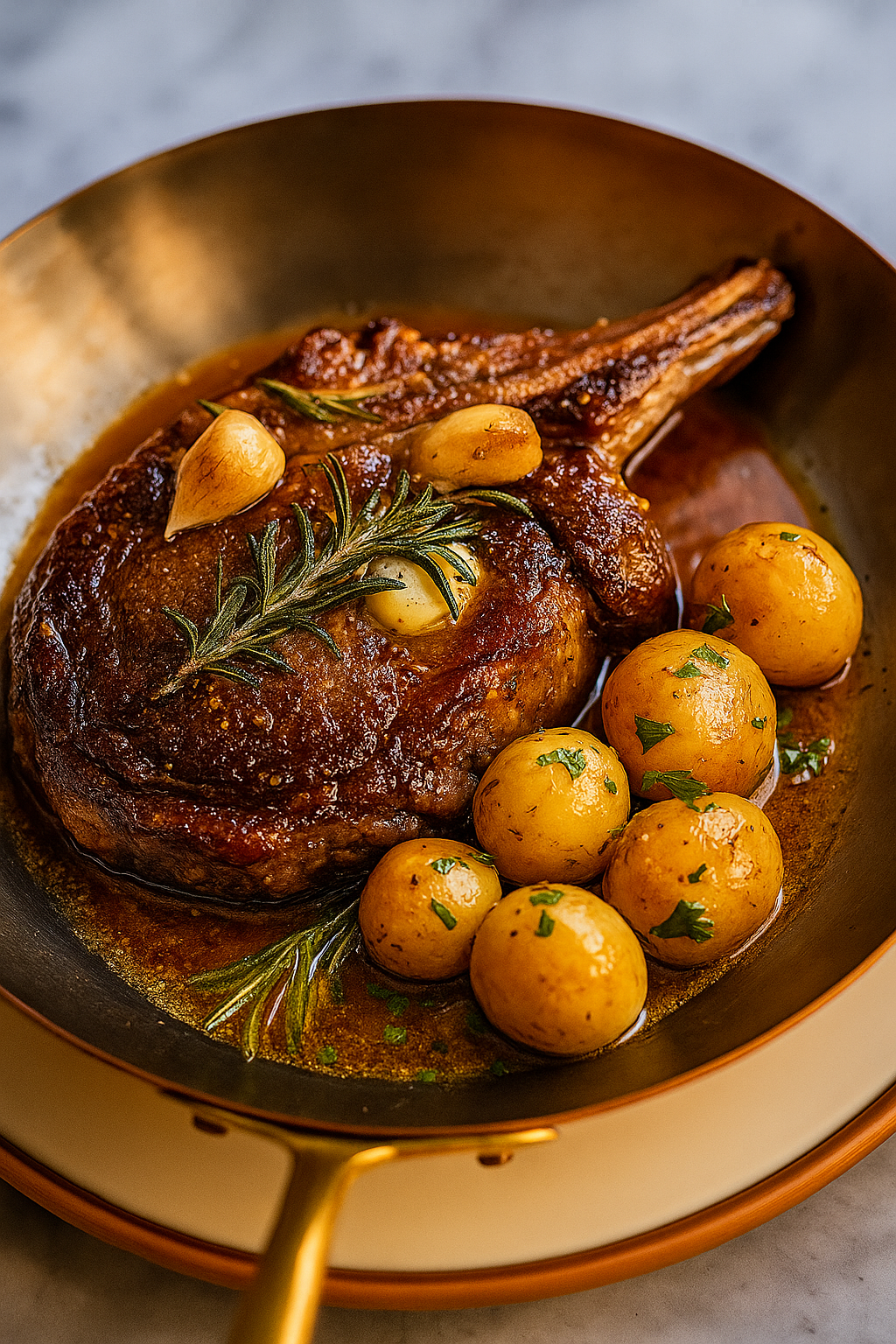
Bone In Ribeye Steak: The Ultimate Juicy Guide for Perfect Results
Ingredients
Method
- 1. Bring the bone in ribeye steak to room temperature for 30–45 minutes.
- 2. Pat the steak dry with paper towels and season generously with salt and pepper.
- 3. Heat a cast iron skillet over high heat until smoking hot.
- 4. Sear the steak for 3–4 minutes per side, including edges.
- 5. Add butter, garlic, and rosemary to the pan and baste the steak for 1–2 minutes.
- 6. Check internal temperature with a meat thermometer.
- 7. Remove steak from pan and rest for 10 minutes before slicing.
- 8. Slice against the grain and serve with sides or sauce of choice.

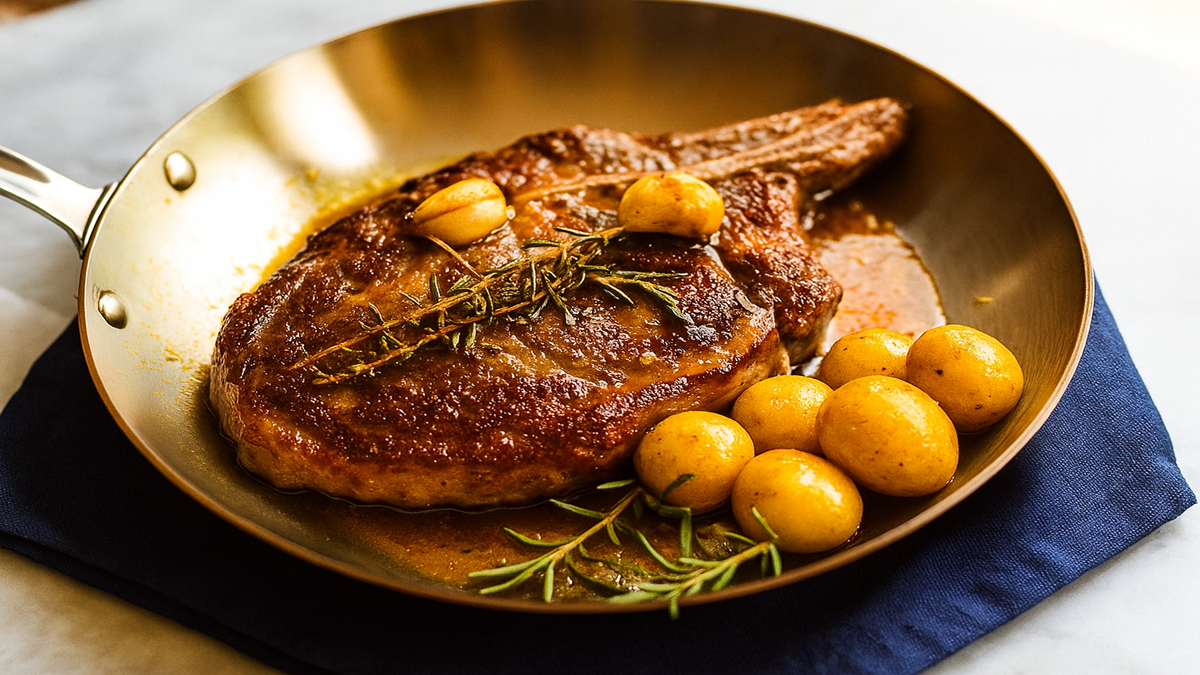
Thank you for sharing ☺️